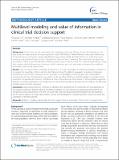| dc.contributor.author | Cui, Yuanyuan | |
| dc.contributor.author | Murphy, Brendan | |
| dc.contributor.author | Gentilcore, Anastasia | |
| dc.contributor.author | Sharma, Yugal | |
| dc.contributor.author | Minasian, Lori M | |
| dc.contributor.author | Kramer, Barnett S | |
| dc.contributor.author | Coates, Paul M | |
| dc.contributor.author | Gohagan, John K | |
| dc.contributor.author | Klenk, Juergen | |
| dc.contributor.author | Tidor, Bruce | |
| dc.contributor.author | Minasian, Lori | |
| dc.date.accessioned | 2016-04-19T18:13:05Z | |
| dc.date.available | 2016-04-19T18:13:05Z | |
| dc.date.issued | 2014-12 | |
| dc.date.submitted | 2014-10 | |
| dc.identifier.issn | 1752-0509 | |
| dc.identifier.uri | http://hdl.handle.net/1721.1/102269 | |
| dc.description.abstract | Background
Clinical trials are the main method for evaluating safety and efficacy of medical interventions and have produced many advances in improving human health. The Women's Health Initiative overturned a half-century of harmful practice in hormone therapy, the National Lung Screening Trial identified the first successful lung cancer screening tool and the Prostate, Lung, Colorectal and Ovarian Cancer Screening Trial overturned decades-long assumptions. While some trials identify unforeseen safety issues or harms, many fail to demonstrate efficacy. Large trials require substantial resources; to ensure reliable outcomes, we must seek ways to improve the predictive information used as the basis of trials.
Results
Here we demonstrate a modeling framework for linking knowledge of underlying biological mechanism to evaluate the expectation of trial outcomes. Key features include the ability to propagate uncertainty in biological mechanism to uncertainty in trial outcome and mechanisms for identifying knowledge gaps most responsible for unexpected outcomes. The framework was used to model the effect of selenium supplementation for prostate cancer prevention and parallels the Selenium and Vitamin E Cancer Prevention Trial that showed no efficacy despite suggestive data from secondary endpoints in the Nutritional Prevention of Cancer trial and found increased incidence of high-grade prostate cancer in certain subgroups.
Conclusion
Using machine learning methods, we identified the parameters of the model that are most predictive of trial outcome and found that the top four are directly related to the rates of reactions producing methylselenol and transporting extracellular selenium into the cell as selenide. This modeling process demonstrates how the approach can be used in advance of a large clinical trial to identify the best targets for conducting further research to reduce the uncertainty in the trial outcome. | en_US |
| dc.description.sponsorship | National Institutes of Health (U.S.). Office of Disease Prevention | en_US |
| dc.description.sponsorship | National Institutes of Health (U.S.). Office of Dietary Supplements | en_US |
| dc.description.sponsorship | Eunice Kennedy Shriver National Institute of Child Health and Human Development (U.S.) | en_US |
| dc.publisher | BioMed Central Ltd | en_US |
| dc.relation.isversionof | http://dx.doi.org/10.1186/s12918-014-0140-0 | en_US |
| dc.rights | Creative Commons Attribution | en_US |
| dc.rights.uri | http://creativecommons.org/licenses/by/4.0 | en_US |
| dc.source | BioMed Central Ltd | en_US |
| dc.title | Multilevel modeling and value of information in clinical trial decision support | en_US |
| dc.type | Article | en_US |
| dc.identifier.citation | Cui, Yuanyuan, Brendan Murphy, Anastasia Gentilcore, Yugal Sharma, Lori M Minasian, Barnett S Kramer, Paul M Coates, John K Gohagan, Juergen Klenk, and Bruce Tidor. “Multilevel Modeling and Value of Information in Clinical Trial Decision Support.” BMC Systems Biology 8, no. 1 (December 2014). | en_US |
| dc.contributor.department | Massachusetts Institute of Technology. Computational and Systems Biology Program | en_US |
| dc.contributor.department | Massachusetts Institute of Technology. Computer Science and Artificial Intelligence Laboratory | en_US |
| dc.contributor.department | Massachusetts Institute of Technology. Department of Electrical Engineering and Computer Science | en_US |
| dc.contributor.mitauthor | Cui, Yuanyuan | en_US |
| dc.contributor.mitauthor | Tidor, Bruce | en_US |
| dc.relation.journal | BMC Systems Biology | en_US |
| dc.eprint.version | Final published version | en_US |
| dc.type.uri | http://purl.org/eprint/type/JournalArticle | en_US |
| eprint.status | http://purl.org/eprint/status/PeerReviewed | en_US |
| dc.date.updated | 2015-01-22T20:04:00Z | |
| dc.language.rfc3066 | en | |
| dc.rights.holder | Yuanyuan Cui et al.; licensee BioMed Central Ltd. | |
| dspace.orderedauthors | Cui, Yuanyuan; Murphy, Brendan; Gentilcore, Anastasia; Sharma, Yugal; Minasian, Lori; Kramer, Barnett S; Coates, Paul M; Gohagan, John K; Klenk, Juergen; Tidor, Bruce | en_US |
| dc.identifier.orcid | https://orcid.org/0000-0002-3320-3969 | |
| mit.license | PUBLISHER_CC | en_US |
